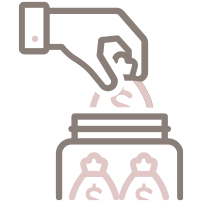Planning your marketing budget for the new year is never easy, especially as a small business owner or entrepreneur. You want to set goals that are ambitious enough to move the needle forward, but also realistic enough for a business of your size. Fortunately, there are steps you can take to make the most out of any marketing budget, no matter how small. The key is to evaluate your marketing performance from the previous year, and to incorporate what you’ve learned into your new strategy.
A quick note: This article won’t cover how to create your marketing budget, but rather our ideas for how to optimize your budget in the new year. For reference, however, the average marketing budget for a small business is usually 7–12 percent of its overall revenue and for those businesses in growth mode, the range is usually 20–30 percent.

1. Follow the data
You’ve heard the famous definition of insanity: doing the same thing over and over and expecting different results. That witticism applies as much to marketing as it does to any other aspect of life. That’s why it’s critical to evaluate last year’s marketing performance and use the data from that assessment to adjust course if necessary.
If a particular campaign didn’t perform as well as you’d hoped, you won’t be doing yourself—or your budget—any favors by repeating it. Instead, use it as information to steer your strategy in a new direction. For instance, if you invested heavily in Facebook ads without seeing a return on that investment, brainstorm platforms where you can better allocate your advertising budget.
It’s not always easy to take an honest look at where your efforts fell short. But if you can think of those areas as information to help you improve rather than failures, you can make impactful changes in your budget and strategy.

2. Prioritize your marketing goals
As a small business owner, you’re ambitious—with good intentions, you try to accomplish the goals that will benefit your audience and bring you revenue as quickly as possible. But trying to do too much, too soon, will only result in money down the drain. To see the return on investment you want, you need to be ruthless about prioritizing which marketing goals are most important for your brand right now. And to do that, you’ll need to get clear on which stage of the brand life cycle you’re currently in, and set your goals accordingly.
This is harder than it sounds, especially when you have an idea for a new campaign that you’re excited about. Let’s say you’re a life coach who just designed a new coaching program. Fired up from a sense of accomplishment and the potential to benefit your audience, you set a goal of launching the program and converting 20 clients. But if you haven’t done the groundwork of building and nurturing an audience, you won’t have any clients to convert, meaning your efforts (and money) will go to waste.
On the other hand, if you can put that program on the back burner and focus instead on building your audience (such as optimizing your social media presence or expanding your email list) your new program will get the attention—and profit—it deserves. Prioritizing your goals doesn’t mean abandoning your passion projects. It just means being strategic about rolling them out.

3. Invest in consistent branding
Some business owners are hesitant to invest a significant portion of their marketing budget into branding. There’s a common misconception that marketing should come before branding, when in reality, the opposite is true.
One of your main goals as a business owner is to make it as easy as possible for your clients to choose you over your competitors—to make your brand as visible, accessible, and recognizable as you can. And the best way to accomplish that is through consistent branding across all platforms. This can look like:
- Designing a new brand logo and establishing brand colors and fonts
- Refining your brand’s messaging, including tone and voice
- Identifying your brand’s archetype to make it relatable and recognizable to your audience
- Ensuring the above elements are identical across all platforms, including your website, social media accounts, and printed marketing collateral
Using precious time and money towards colors and logos can seem risky for practical-minded business owners. But investing in consistent branding at the beginning of your journey will ultimately result in a powerful ROI and increase your brand’s overall value.

4. Refine your target audience
It’s easy to think that by trying to serve as many people as possible, you’ll make a bigger profit. But while there are a few big brands (such as Google, Amazon, and Apple) who have successfully cast a wide net, small businesses are much better off speaking to a specific niche. To make the most of your marketing budget, you need to refine your target audience and commit to serving them—and only them.
To effectively serve your refined audience, you’ll need to understand not only your ideal client’s demographics, but their psyche. If you can speak directly to your audience’s core motivations and fears, you can successfully position your brand as the solution to their problems, making it much more likely that they’ll choose to financially invest in your business.

5. Let your audience lead you
Too often, businesses invest their marketing budgets into trying to force their audience to come to them, instead of going where their audience already is. It doesn’t matter how well you’ve optimized your brand on Facebook—if you serve a younger audience who favors Instagram, you’re not going to see the return on your investment.
Likewise, take a look at the efforts that have gained the highest audience engagement. This could be in terms of social media—which hashtags attract the most attention, or whether your audience is more likely to engage with videos or still images—but it applies outside social platforms as well. If the trade show you attended last year brought in dozens of new clients, include more in-person events in this year’s budget. On the other hand, if most of your conversion is the result of email marketing, consider investing in an improved automated platform.
Remember: “If you build it, they will come” is a famous movie quote, not a profitable marketing strategy. To make the most of your budget, go where your audience already is, instead of wasting resources trying to bring them into a new space.

6. Give more to get more
It sounds counterintuitive, but one proven strategy for boosting conversion rates and increasing sales numbers in the new year is to give more away for free. This doesn’t mean you should stop charging for your services—you’re an entrepreneur, not a volunteer! But providing your prospective clients with something of real value, without any monetary strings attached, is a great way to build trust and encourage lead conversion. To pack an even more powerful punch, create a direct progression from your free offer to a paid offer.
Here are a few examples of what this might look like:
- A free download of one section of a workbook included in a coaching subscription program
- A free trial lesson at a music school
- A quiz that gives the audience their results in exchange for their email address
- A complimentary consultation call with a design firm
- A free service quote from a home improvement company
Whatever your free offer, make sure that it provides some true value to your prospective clients, regardless of whether they choose to invest further in your brand. Even if they decide against it, they’ll walk away with a positive impression and will be more likely to choose you if they require your services in the future.

7. Show love to your current clients
Conversion tends to be the primary focus of any marketing budget. But don’t forget to allocate resources to those who have already invested in your brand. Showing gratitude and appreciation for your current clients will go a long way in building brand loyalty, which creates a positive feedback loop for your sales and ROI.
Consider holding a regular promotion on a monthly or quarterly basis available to your current clients. Restaurants and product-based brands, for example, often see success with birthday gifts. The small promise of a free dessert or coupon code on a client’s special day not only encourages excitement and gives your clients something to look forward to, but can also boost revenue, solidify brand loyalty, and foster an emotional connection.
Make an impact in the new year
Accomplishing your biggest marketing goals on a small budget is a challenge for any business owner, but it is possible. If you can be honest about where your business is and where your marketing fell short last year, and use that information to adjust your course, you’ll be well on your way to strengthening your brand. The ideas we’ve shared in this article will help you make the most out of any budget, no matter how small, in this new year and in the years to come.
Don’t want to miss out on our articles and insights?
Sign up for the Miss Details newsletter today.



